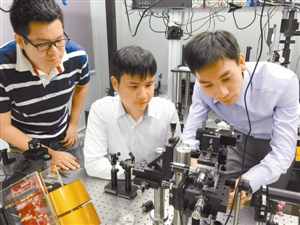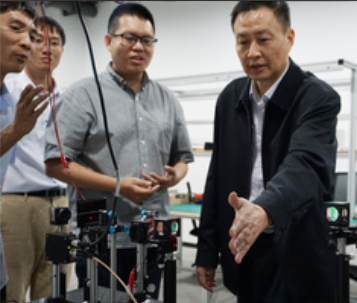
core members of the team-leader Professor Lin Jiao, Professor du Luping (right), Dr. Lei Ting at work
"post-80s" doctors have returned to China to start their own businesses.
The Shenzhen University Nanophotonics Research Center undertakes 17 scientific research projects, including major research instrument development projects, major projects, key projects, excellent youth projects, and the 973 project of the Ministry of Science and Technology of the State Foundation of China. And Shenzhen Peacock Program Talent start-up Project and other 17 scientific research projects. "Peacock team" nanometer optoelectronics high-end instrument research and development team leader Professor Lin Jiao is one of them. The average age of the team he leads is only 30, and the four core members are all post-80s. Professor Lin Jiao, 35, is the eldest member of the team.
Professor Lin Jiao has worked in the innovation Bureau of Singapore and Harvard University successively. Since 2014, he has been a distinguished professor of Shenzhen University, mainly engaged in the design and Application Research of nano optoelectronic devices. His research has realized the directional coupling of reconfigurable polarization controlled surface plasmon for the first time in the world. This technology has broad application prospects in the development of large-scale surface optoelectronic integration and interconnection technology in the future. The related achievements were published in the international top academic journal Science in 2013.
Professor du Luping graduated from Nanyang University of Technology in Singapore, mainly engaged in the research and development of super-resolution microscopic imaging technology. His recent work has solved the physical problem of "degenerate response of metal nano-aperture to optical spin" for the first time. This technology has a wide application prospect in integrated spin optoelectronic devices, optical communication and chiral detection of biological samples, and the related work will be published in the top international academic journal Nature-Communication. Lei Ting, who received his doctorate from Hong Kong University of Science and Technology in 2013, pioneered the "Optical Vortex Daman grating" technology, which realized the efficient parallel detection of multi-track angular momentum, broke through the bottleneck of optical communication capacity and set a record for 160Tbit/s capacity. Professor Wang Ke gave up his postdoctoral status at Cornell University in the United States and returned home last year to devote himself to scientific research.
In the past two years, Lin Jiao, du Luping, Lei Ting and Wang Ke, four PhDs in optics from the other side of the ocean, have successively entered the College of Optoelectronics of Shenzhen University through the Peacock Project, giving full play to their expertise in their respective fields.





